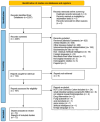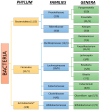A Systematic Review of Microbiota in Cirrhosis: A Change Towards a More Pathogenic Predisposition
- PMID: 39859243
- PMCID: PMC11765289
- DOI: 10.3390/ijms26020527
A Systematic Review of Microbiota in Cirrhosis: A Change Towards a More Pathogenic Predisposition
Abstract
The microbiome of the human intestine is a regulator of health that modulates immune response and plays an important role in metabolism. The diversity, and abundance of microbiota communities in the gut have been shown to change in cirrhosis and its complications. We aimed to review the current knowledge regarding microbiota alterations in cirrhosis, its potential differences according to etiology, and its role in the development of cirrhosis complications. A systematic search of the online bibliographic database up to July 2024 was performed. Randomized controlled trials and observational and cohort studies that included a total or at least a cohort of cirrhotic adult patients were enlisted for data extraction and analysis. A total of 73 publications were included for data extraction. Alpha diversity was found to decrease in cirrhotic patients in 30/38 (78%) of the studies, while beta diversity in 20/22 (90%) presented significant differences between healthy and cirrhotic groups. Proteobacteria significantly increased in 20/27 (74%) studies, followed by Actinobacteria and Fusobacteria, while 22/25 (88%) studies found either a reduction in cirrhotic patients or increased abundance in healthy controls for Firmicutes and Bacteroidetes. The most abundant genera in hepatic encephalopathy groups were pathobionts such as Enterococcus and Streptococcus, followed by Vellionella and Escherichia. Heterogeneity was found among studies regarding Alpha diversity in hepatocellular carcinoma (HCC) as it was decreased in three studies, indifferent in five, and increased in three studies in comparison to cirrhotic non-HCC patients. The dysbiosis of the gut microbiota is associated with cirrhosis and the development of complications such as hepatic encephalopathy and hepatocellular carcinoma.
Keywords: bacterial overgrowth; cirrhosis; dysbiosis; hepatic encephalopathy; hepatocellular carcinoma; microbiota.
Conflict of interest statement
The authors declare no conflict of interest.
Figures






References
-
- Xirouchakis E., Manousou P., Tsartsali L., Georgopoulos S.D., Burroughs A.K. Insights into the pathogenesis of NAFLD: The role of metabolic and pro-inflammatory mediators. Ann. Gastroenterol. 2009;22:24–33.
Publication types
MeSH terms
LinkOut - more resources
Full Text Sources
Medical

